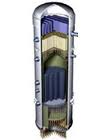US Nuclear Body Seeks Comment On Certifying GE-Hitachi Nuclear Reactor Design
The U.S. Nuclear Regulatory Commission is seeking comments on a proposed rule that would certify GE-Hitachi Nuclear Energy’s Economic Simplified Boiling-Water Reactor (ESBWR) design for use in the United States.
The design certification process provides for early public participation and resolution of safety issues for proposed reactor designs, the NRC said. NRC certification, in the form of a final rule, means the design meets the agency’s applicable safety requirements.
If an applicant for a nuclear power plant license references a certified design, the applicant need not submit safety information for the design. Instead, the license application and the NRC’s safety review would address the remaining safety issues for the proposed nuclear power plant.
The design to be certified is fully described in a “design control document,” which would be approved (incorporated by reference) in the design certification rule. The NRC has also prepared an environmental assessment of the design to support the rulemaking. The environmental assessment discusses possible design alternatives that could be included in the design certification to mitigate potential severe accidents.

According to a GEH presentation on the corporate website, “GE Hitachi Nuclear Energy’s (GEH) next evolution of advanced
Boiling Water Reactor (BWR) technology is the ESBWR. This simplified design provides improved safety; excellent economics; better plant security; a broad seismic design envelope; and operational flexibility that increases plant availability.”
GE-Hitachi Nuclear Energy submitted an application for certification of the ESBWR standard plant design on Aug. 24, 2005. The ESBWR is a 1,594 megawatt electric, natural circulation reactor.
The ESBWR includes passive safety features that would cool down the reactor after an accident without the need for human intervention. These passive features include an enhanced natural circulation via a taller reactor vessel, a shorter core and improved water flow through the vessel; an isolation condenser system to control water levels and remove decay heat while the reactor is pressurized, and a gravity-driven cooling system to maintain water levels when the reactor pressure has dropped.
The NRC conducted an extensive technical evaluation of the design and issued a final safety evaluation report (FSER) in March 2011.
The NRC is currently reviewing a Combined License application, referencing the ESBWR design certification application, from the Detroit Edison Company for Fermi Unit 3. The NRC has certified four other standard reactor designs: the Advanced Boiling Water Reactor (ABWR), System 80+, AP600, and AP1000, and the agency has published proposed rules to amend the ABWR and the AP1000.
Five of the six reactors at Fukushima I are GE’s so-called Mark 1 boiling water reactor models, developed in the 1960s and installed in Japan in the 1970s, and not the same model as the ESWBR.
